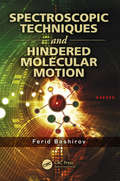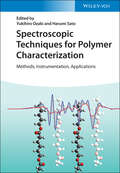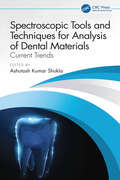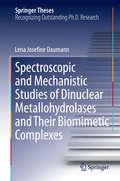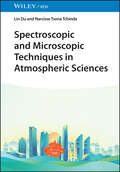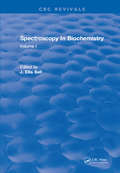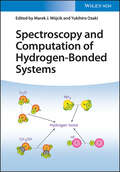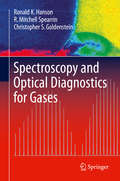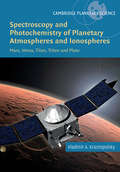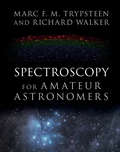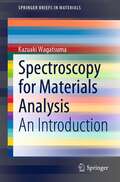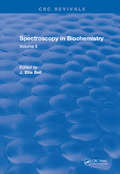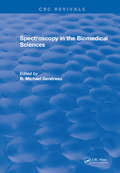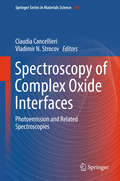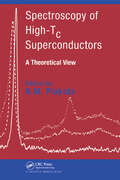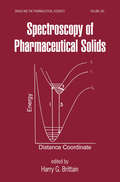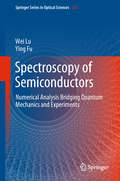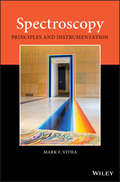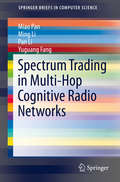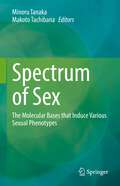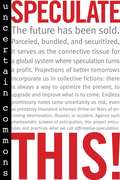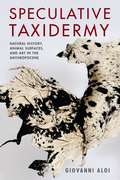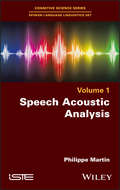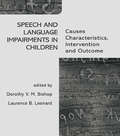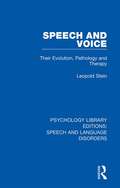- Table View
- List View
Spectroscopic Techniques and Hindered Molecular Motion
by Ferid BashirovSpectroscopic Techniques and Hindered Molecular Motion presents a united, theoretical approach to studying classical local thermal motion of small molecules and molecular fragments in crystals by spectroscopic techniques. Mono- and polycrystalline case studies demonstrate performance validity. The book focuses on small molecules and molecular fragm
Spectroscopic Techniques for Polymer Characterization: Methods, Instrumentation, Applications
by Yukihiro Ozaki|An insightful exploration of cutting-edge spectroscopic techniques in polymer characterization In Spectroscopic Techniques for Polymer Characterization: Methods, Instrumentation, Applications, a team of distinguished chemists delivers a comprehensive exploration of the vast potential of spectroscopic characterization techniques in polymer research. The book offers a concise outline of the principles, advantages, instrumentation, experimental techniques, and noteworthy applications of cutting-edge spectroscopy. Covering a wide range of polymers, from nylon to complex polymeric nanocomposites, the author presents recent developments in polymer science to polymer, analytical, and material chemists, assisting them in keeping track of the progress in modern spectroscopy. Spectroscopic Techniques for Polymer Characterization contains contributions from pioneers in modern spectroscopic techniques from around the world. The included materials bridge the gap between spectroscopists, polymer scientists, and engineers in academia and industry. The book also offers: A thorough introduction to the progress in spectroscopic techniques, including polymer spectroscopy and near-infrared spectroscopy Comprehensive explorations of topical polymers studied by spectroscopy, including polymer thin films, fluoropolymers, polymer solutions, conductive polymers Practical discussions of infrared imaging, near-infrared imaging, two-dimensional correlation spectroscopy, and far-ultraviolet spectroscopy In-depth examinations of spectroscopic studies of weak hydrogen bonding in polymers Spectroscopic Techniques for Polymer Characterization: Methods, Instrumentation, Applications is a must-read reference for polymer, analytical, and physical chemists, as well as materials scientists and spectroscopists seeking a one-stop resource for polymer characterization using spectroscopic analyses.
Spectroscopic Tools and Techniques for Analysis of Dental Materials: Current Trends
by Ashutosh Kumar ShuklaSpectroscopic Tools and Techniques for Analysis of Dental Materials: Current Trends introduces the dental materials and spectroscopic techniques applied for the analysis of such materials, including ceramic, metallic, polymeric and composites. The following individual chapters are primarily based on particular spectroscopic techniques and their applications, including X-ray Spectroscopy, Ultraviolet & visible spectroscopy, Fourier Transfer Infrared Spectroscopy, Raman Spectroscopy and Mass spectrometry. Different oral diseases, caries, calculus, periodontitis and oral mucosal diseases such as oral cancer, will be discussed as well.This is an ideal book for dental professionals, researchers and students interested in the analysis of dental materials.Key Features: Individual chapters include brief introductions of specific techniques Mathematical details are kept at a necessary minimum level Includes case studies to suit the target audience
Spectroscopic and Mechanistic Studies of Dinuclear Metallohydrolases and Their Biomimetic Complexes
by Lena Josefine DaumannLena Daumanns's thesis describes structural and functional studies of the enzyme Glycerophosphodiesterase (GpdQ) from Enterobacter aerogenes. It also examines the properties of small mimics of this enzyme and related binuclear metallohydrolases such as the metallo-ß-lactamases to enhance our understanding of hydrolytic cleavage of important substrates like phosphoesters and β-lactams. Overall, this project has led to a better understanding of the metal ion binding and active site structural features of the enzyme GpdQ. Daumann describes how she successfully immobilized phosphoesterase and related biomimetics on solid supports for potential applications in the area of bioremediation of organophosphate pesticides. Analysis shows that both the enzyme and biomimetics can be stored on the solid support without loss of activity. Furthermore, the author specroscopically and mechanistically characterized a number of Zn(II), Cd(II) and Co(II) complexes, some of which are among the most active biomimetics towards organophosphates reported to date. This thesis makes excellent reading for non-specialists because each chapter includes a short introduction section.
Spectroscopic and Microscopic Techniques in Atmospheric Sciences
by Lin Du Narcisse Tsona TchindaA timely and current discussion of instrumental techniques in atmospheric sciences In Spectroscopic and Microscopic Techniques in Atmospheric Sciences, a team of distinguished researchers delivers an authoritative and up-to-date discussion of the latest developments in sophisticated analytical techniques and their applications in atmospheric sciences, including chemical identification and characterization, determination of reaction mechanisms and kinetics, and qualitative and quantitative analysis. Each chapter presents the development of a different analytical method from first principles and highlights the major developments in the technique to date. The book also covers the weaknesses and strengths of each technique and the suitability of its applications in indicated environmental media. Readers will also find: A thorough introduction to relevant atmospheric processesComprehensive explorations of mass spectrometry and optical, electron, and atomic force microscopyPractical discussions of fluorescence spectroscopy and ultraviolet-visible absorption spectroscopyComplete treatments of infrared spectroscopy and Raman spectroscopy Perfect for graduate students undertaking courses in atmospheric sciences, Spectroscopic and Microscopic Techniques in Atmospheric Sciences will also benefit environmental chemists, climatologists, and analytical chemists.
Spectroscopy In Biochemistry: Volume I
by J.Ellis BellThis book has been written in part with the aim of providing a text which will be useful in teaching the biochemical applications of spectroscopy. This book will be of particular use to the biochemist or biologist who does not have a background in spectroscopy, but desires to find out what sort of information spectroscopy can provide. Attention was limited to those techniques most frequently used, and which at present have the widest applications.
Spectroscopy and Computation of Hydrogen-Bonded Systems
by Yukihiro Ozaki Marek J. WójcikSpectroscopy and Computation of Hydrogen-Bonded Systems Comprehensive spectroscopic view of the state-of the-art in theoretical and experimental hydrogen bonding research Spectroscopy and Computation of Hydrogen-Bonded Systems includes diverse research efforts spanning the frontiers of hydrogen bonding as revealed through state-of-the-art spectroscopic and computational methods, covering a broad range of experimental and theoretical methodologies used to investigate and understand hydrogen bonding. The work explores the key quantitative relationships between fundamental vibrational frequencies and hydrogen-bond length/strength and provides an extensive reference for the advancement of scientific knowledge on hydrogen-bonded systems. Theoretical models of vibrational landscapes in hydrogen-bonded systems, as well as kindred studies designed to interpret intricate spectral features in gaseous complexes, liquids, crystals, ices, polymers, and nanocomposites, serve to elucidate the provenance of spectroscopic findings. Results of experimental and theoretical studies on multidimensional proton transfer are also presented. Edited by two highly qualified researchers in the field, sample topics covered in Spectroscopy and Computation of Hydrogen-Bonded Systems include: Quantum-mechanical treatments of tunneling-mediated pathways and molecular-dynamics simulations of structure and dynamics in hydrogen-bonded systems Mechanisms of multiple proton-transfer pathways in hydrogen-bonded clusters and modern spectroscopic tools with synergistic quantum-chemical analyses Mechanistic investigations of deuterium kinetic isotope effects, ab initio path integral methods, and molecular-dynamics simulations Key relationships that exist between fundamental vibrational frequencies and hydrogen-bond length/strength Analogous spectroscopic and semi-empirical computational techniques examining larger hydrogen-bonded systems Reflecting the polymorphic nature of hydrogen bonding and bringing together the latest experimental and computational work in the field, Spectroscopy and Computation of Hydrogen-Bonded Systems is an essential resource for chemists and other scientists involved in projects or research that intersects with the topics covered within.
Spectroscopy and Optical Diagnostics for Gases
by Ronald K. Hanson R. Mitchell Spearrin Christopher S. GoldensteinThis text provides an introduction to the science that governs the interaction of light and matter (in the gas phase). It provides readers with the basic knowledge to exploit the light-matter interaction to develop quantitative tools for gas analysis (i. e. optical diagnostics) and understand and interpret the results of spectroscopic measurements. The authors pair the basics of gasphase spectroscopy with coverage of key optical diagnostic techniques utilized by practicing engineers and scientists to measure fundamental flowfield properties. The text is organized to cover three subtopics of gasphase spectroscopy: (1) spectral line positions, (2) spectral line strengths, and (3) spectral lineshapes by way of absorption, emission, and scattering interactions. The latter part of the book describes optical measurement techniques and equipment. Key subspecialties include laser induced fluorescence, tunable laser absorption spectroscopy, and wavelength modulation spectroscopy. It is ideal for students and practitioners across a range of applied sciences including mechanical, aerospace, chemical, and materials engineering.
Spectroscopy and Photochemistry of Planetary Atmospheres and Ionospheres: Mars, Venus, Titan, Triton and Pluto (Cambridge Planetary Science #23)
by Vladimir A. KrasnopolskyThe chemical composition of any planetary atmosphere is of fundamental importance in determining its photochemistry and dynamics in addition to its thermal balance, climate, origin and evolution. Divided into two parts, this book begins with a set of introductory chapters, starting with a concise review of the Solar System and fundamental atmospheric physics. Chapters then describe the basic principles and methods of spectroscopy, the main tool for studying the chemical composition of planetary atmospheres, and of photochemical modeling and its use in the theoretical interpretation of observational data on chemical composition. The second part of the book provides a detailed review of the carbon dioxide atmospheres and ionospheres of Mars and Venus, and the nitrogen-methane atmospheres of Titan, Triton and Pluto. Written by an expert author, this comprehensive text will make a valuable reference for graduate students, researchers and professional scientists specializing in planetary atmospheres.
Spectroscopy for Amateur Astronomers: Recording, Processing, Analysis and Interpretation
by Richard Walker Trypsteen Marc F. M.This accessible guide presents the astrophysical concepts behind astronomical spectroscopy, covering both the theory and the practical elements of recording, processing, analysing and interpreting your spectra. It covers astronomical objects, such as stars, planets, nebulae, novae, supernovae, and events such as eclipses and comet passages. Suitable for anyone with only a little background knowledge and access to amateur-level equipment, the guide's many illustrations, sketches and figures will help you understand and practise this scientifically important and growing field of amateur astronomy, up to the level of Pro-Am collaborations. Accessible to non-academics, it benefits many groups from novices and learners in astronomy clubs, to advanced students and teachers of astrophysics. This volume is the perfect companion to the Spectral Atlas for Amateur Astronomers, which provides detailed commented spectral profiles of more than 100 astronomical objects.
Spectroscopy for Materials Analysis: An Introduction (SpringerBriefs in Materials)
by Kazuaki WagatsumaThis book includes X-ray fluorescence spectroscopy, electron spectroscopy, and atomic emission spectroscopy, which are now extensively employed in material analysis. This book is organized as a guide for undergraduate students and engineers who wish to study analytical spectroscopy in material science. An objective of this book is to explain the principles of those methods of spectroscopy only with basic mathematical expressions and to introduce their applications to actual materials.
Spectroscopy in Biochemistry: Volume II
by J.Ellis BellThis book has been written in part with the aim of providing a text which will be useful in teaching the biochemical applications of spectroscopy. This book will be of particular use to the biochemist or biologist who does not have a background in spectroscopy, but desires to find out what sort of information spectroscopy can provide. Attention was limited to those techniques most frequently used, and which at present have the widest applications.
Spectroscopy in the Biomedical Sciences
by R.M. GendreauThe intent of this book � a collection of manuscripts - is to provide general descriptions of analytical techniques which we believe to be useful to the biological scientist, and to provide examples of the utility of each technique. The contributing authors were asked to focus on examples in which their particular technique has proven particularly useful in studies of biological systems. Many commonly used analytical techniques such as NMR and ESR are not included in this work, it is preferred to focus on techniques which perhaps have not received as much coverage as in the recent literature. All of the analytical tools covered in this volume have great utility, and the scientific community can expect to see increasing usage of most if not all of these techniques.
Spectroscopy of Complex Oxide Interfaces: Photoemission And Related Spectroscopies (Springer Series in Materials Science #266)
by Claudia Cancellieri Vladimir N. StrocovThis book summarizes the most recent and compelling experimental results for complex oxide interfaces. The results of this book were obtained with the cutting-edge photoemission technique at highest energy resolution. Due to their fascinating properties for new-generation electronic devices and the challenge of investigating buried regions, the book chiefly focuses on complex oxide interfaces. The crucial feature of exploring buried interfaces is the use of soft X-ray angle-resolved photoemission spectroscopy (ARPES) operating on the energy range of a few hundred eV to increase the photoelectron mean free path, enabling the photons to penetrate through the top layers – in contrast to conventional ultraviolet (UV)-ARPES techniques. The results presented here, achieved by different research groups around the world, are summarized in a clearly structured way and discussed in comparison with other photoemission spectroscopy techniques and other oxide materials. They are complemented and supported by the most recent theoretical calculations as well as results of complementary experimental techniques including electron transport and inelastic resonant X-ray scattering.
Spectroscopy of High-Tc Superconductors: A Theoretical View
by N. M. PlakidaDespite ten years of intensive research, many questions remain unanswered concerning the nature of the electronic structure (Fermi vs non-Fermi liquid) and mechanisms of superconductivity. Spectroscopy of High-Tc Superconductors, A Theoretical View provides a current, comprehensive review of the experimental results and theoretical interpre
Spectroscopy of Pharmaceutical Solids
by Harry G. BrittainSelecting illustrative examples from the recent literature, this reference studies the underlying principles and physics of a wide range of spectroscopic techniques utilized in the pharmaceutical sciences and demonstrates various applications for each method analyzed in the text-showing how knowledge of the mechanisms of spectroscopic phenomena may
Spectroscopy of Semiconductors: Numerical Analysis Bridging Quantum Mechanics And Experiments (Springer Series in Optical Sciences #215)
by Ying Fu Wei LuThe science and technology related to semiconductors have received significant attention for applications in various fields including microelectronics, nanophotonics, and biotechnologies. Understanding of semiconductors has advanced to such a level that we are now able to design novel system complexes before we go for the proof-of-principle experimental demonstration.This book explains the experimental setups for optical spectral analysis of semiconductors and describes the experimental methods and the basic quantum mechanical principles underlying the fast-developing nanotechnology for semiconductors. Further, it uses numerous case studies with detailed theoretical discussions and calculations to demonstrate the data analysis. Covering structures ranging from bulk to the nanoscale, it examines applications in the semiconductor industry and biomedicine. Starting from the most basic physics of geometric optics, wave optics, quantum mechanics, solid-state physics, it provides a self-contained resource on the subject for university undergraduates. The book can be further used as a toolbox for researching and developing semiconductor nanotechnology based on spectroscopy.
Spectroscopy: Principles and Instrumentation
by Mark F. VithaProvides students and practitioners with a comprehensive understanding of the theory of spectroscopy and the design and use of spectrophotometers In this book, you will learn the fundamental principles underpinning molecular spectroscopy and the connections between those principles and the design of spectrophotometers. Spectroscopy, along with chromatography, mass spectrometry, and electrochemistry, is an important and widely-used analytical technique. Applications of spectroscopy include air quality monitoring, compound identification, and the analysis of paintings and culturally important artifacts. This book introduces students to the fundamentals of molecular spectroscopy – including UV-visible, infrared, fluorescence, and Raman spectroscopy – in an approachable and comprehensive way. It goes beyond the basics of the subject and provides a detailed look at the interplay between theory and practice, making it ideal for courses in quantitative analysis, instrumental analysis, and biochemistry, as well as courses focused solely on spectroscopy. It is also a valuable resource for practitioners working in laboratories who regularly perform spectroscopic analyses. Spectroscopy: Principles and Instrumentation: Provides extensive coverage of principles, instrumentation, and applications of molecular spectroscopy Facilitates a modular approach to teaching and learning about chemical instrumentation Helps students visualize the effects that electromagnetic radiation in different regions of the spectrum has on matter Connects the fundamental theory of the effects of electromagnetic radiation on matter to the design and use of spectrophotometers Features numerous figures and diagrams to facilitate learning Includes several worked examples and companion exercises throughout each chapter so that readers can check their understanding Offers numerous problems at the end of each chapter to allow readers to apply what they have learned Includes case studies that illustrate how spectroscopy is used in practice, including analyzing works of art, studying the kinetics of enzymatic reactions, detecting explosives, and determining the DNA sequence of the human genome Complements Chromatography: Principles and Instrumentation The book is divided into five chapters that cover the Fundamentals of Spectroscopy, UV-visible Spectroscopy, Fluorescence/Luminescence Spectroscopy, Infrared Spectroscopy, and Raman Spectroscopy. Each chapter details the theory upon which the specific techniques are based, provides ways for readers to visualize the molecular-level effects of electromagnetic radiation on matter, describes the design and components of spectrophotometers, discusses applications of each type of spectroscopy, and includes case studies that illustrate specific applications of spectroscopy. Each chapter is divided into multiple sections using headings and subheadings, making it easy for readers to work through the book and to find specific information relevant to their interests. Numerous figures, exercises, worked examples, and end-of-chapter problems reinforce important concepts and facilitate learning. Spectroscopy: Principles and Instrumentation is an excellent text that prepares undergraduate students and practitioners to operate in modern laboratories.
Spectrum Trading in Multi-Hop Cognitive Radio Networks
by Ming Li Miao Pan Pan Li Yuguang FangThis SpringerBrief focuses on spectrum trading designs in multi-hop cognitive radio networks. It starts with the motivation for spectrum trading and the review of existing spectrum trading designs. Then, it presents a novel CRN architecture for spectrum trading considering spectrum trading's economic features and wireless nature. Under this network architecture, it extends current single-hop per-user based spectrum trading design into a multi-hop transmission opportunity based one, and further into a session based one, while having economic properties guaranteed. This SpringerBrief not only provides a good review of current spectrum trading designs, it also touches on the cutting-edge interdisciplinary spectrum trading research on disparate fields of modeling, network architecture design, optimization theories, statistics, and economic theories. Advanced-level students studying computer science, electrical and computer engineering and economics, wireless network planners, and wireless spectrum engineers will find this book a useful tool.
Spectrum of Sex: The Molecular Bases that Induce Various Sexual Phenotypes
by Minoru Tanaka Makoto TachibanaThis book introduces cutting-edge studies on the spectrum of sex. The sex spectrum can be understood as an interwoven mechanism sustaining graded phenotypes between the two sexes. The book overviews three elements that develop the sex spectrum: genetics, the endocrine system, and the environment. Part I discusses the genetic regulation during sex determination, which often results in a mixture of two sexes or sex reversal. The evolutionary aspects of the genetic determinants are also discussed. Part II presents the involvement of endocrine regulation in the sex spectrum, which covers a broad range of phenotypic events, including sexual behavior and metabolism. Interestingly, sex hormones can also act as sex determinants. Finally, Part III shows that intrinsic factors, such as sex-determining genes and sex hormones, are not the only factors in sex development. The environment surrounding organisms, such as symbiosis and metabolism, act on the sex as critical factors, generating the sex spectrum. Determination and development of the two sexes have been a topic of great interest and a long-standing issue in biology. The book updates the conventional view that biological sex is fixed after birth and sets new perspectives for understanding sex as a spectrum manifested in multiple phenomena. Each chapter contributed by leading experts explains the sex spectrum in various organisms and their underlying mechanisms from the latest ongoing studies. The book provides a valuable resource for not only experts in developmental biology, physiology, and medical science, but also non-scientists and anyone interested in the topic.
Speculate This!
by Uncertain CommonsA short, timely manifesto critiquing predatory modes of financial speculation that seek to minimize uncertainty and risk, while advocating speculative practices that embrace uncertainty, spur radical change, and enable alternative futures.
Speculative Taxidermy: Natural History, Animal Surfaces, and Art in the Anthropocene (Critical Life Studies)
by Giovanni AloiTaxidermy, once the province of natural history and dedicated to the pursuit of lifelike realism, has recently resurfaced in the world of contemporary art, culture, and interior design. In Speculative Taxidermy, Giovanni Aloi offers a comprehensive mapping of the discourses and practices that have enabled the emergence of taxidermy in contemporary art. Drawing on the speculative turn in philosophy and recovering past alternative histories of art and materiality from a biopolitical perspective, Aloi theorizes speculative taxidermy: a powerful interface that unlocks new ethical and political opportunities in human-animal relationships and speaks to how animal representation conveys the urgency of addressing climate change, capitalist exploitation, and mass extinction.A resolutely nonanthropocentric take on the materiality of one of the most controversial mediums in art, this approach relentlessly questions past and present ideas of human separation from the animal kingdom. It situates taxidermy as a powerful interface between humans and animals, rooted in a shared ontological and physical vulnerability. Carefully considering a select number of key examples including the work of Nandipha Mntambo, Maria Papadimitriou, Mark Dion, Berlinde De Bruyckere, Roni Horn, Oleg Kulik, Steve Bishop, Snæbjörnsdóttir/Wilson, and Cole Swanson, Speculative Taxidermy contextualizes the resilient presence of animal skin in the gallery space as a productive opportunity to rethink ethical and political stances in human-animal relationships.
Speech Acoustic Analysis
by Philippe MartinThe text sets out in simple and accessible terms the various methods of acoustic analysis of speech, placing them in their historical context, allowing a better understanding of the mathematical and technical solutions adopted today in phonetics and experimental phonology. Without mathematical complications, the operating bases of the many speech analysis software currently available are exposed so that everyone can understand the limits and avoid errors and misinterpretations in their implementation.
Speech and Language Impairments in Children: Causes, Characteristics, Intervention and Outcome
by Laurence B. Leonard Dorothy V.M. BishopDelayed development of speech and/or language is one of the commonest reasons for parents of preschool children to seek the advice of a paediatrician.Accessible to non-academic Speech and Language Impairments provides an overview of recent research developments in specific speech and language impairments, written by experts in the field. Topics include normal and disordered development of problems , crosslinguistic studies, pragmatic language impairments, early identification, educational and psychiatric outcomes, acquired epileptic aphasia and experimental studies of remediation. The book concludes with a chapter by Michael Rutter that gives guidelines for conducting and evaluating research in this field.
Speech and Voice: Their Evolution, Pathology and Therapy (Psychology Library Editions: Speech and Language Disorders)
by Leopold SteinOriginally published in 1942, this title was recognised as setting new standards in the scientific approach to speech problems. Much speech therapy in the past had been unsatisfactory because of its emphasis upon the purely mechanical aspects of the condition, while at the same time the purely psychological approach was not sufficient to lead to satisfactory and radical treatment either. In this title the author combines the two approaches and by setting out the basic pathology of the various conditions, he throws new light upon them. Today it can be read and enjoyed in its historical context.
